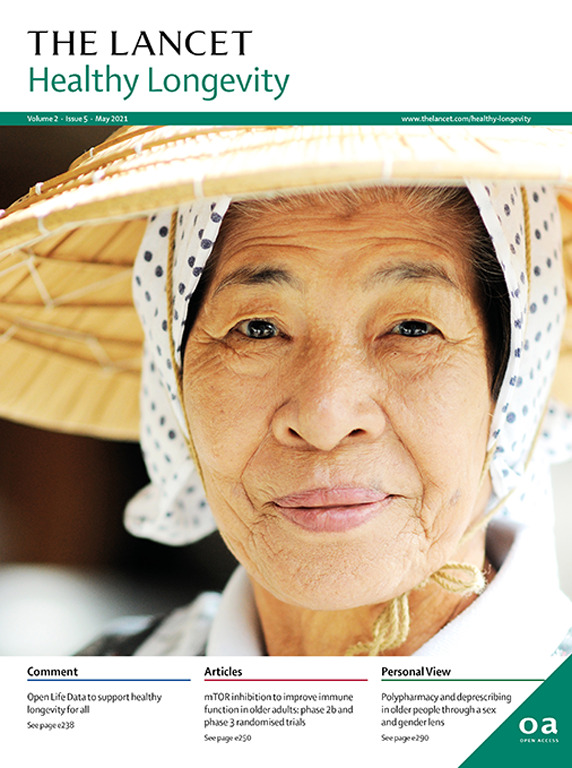Bone quality response to lifestyle intervention in older adults with obesity (LIMB-Q trial): a randomised controlled trial
IF 14.6
Q1 GERIATRICS & GERONTOLOGY
引用次数: 0
Abstract
Background
Lifestyle interventions for weight loss might exacerbate age-related bone loss and osteoporosis. However, there is limited knowledge about their effects on bone quality. We examined whether lifestyle intervention can preserve or enhance bone quality, despite reductions in bone mineral density.
Methods
The Lifestyle Intervention to Improve Bone Quality (LIMB-Q) study was a randomised controlled trial conducted at Baylor College of Medicine and the Michael E DeBakey VA Medical Center (Houston, TX, USA) including older adults (aged 65–85 years) with obesity (BMI ≥30 kg/m2). Participants were randomly assigned to receive either an intensive lifestyle intervention (intensive lifestyle group, consisting of weight management plus exercise training) or healthy lifestyle (healthy lifestyle group, consisting of educational sessions on healthy diets). The co-primary outcomes were 12-month changes in (1) distal tibia cortical thickness, measured using high-resolution peripheral quantitative CT, and (2) hip bone strength (failure load), assessed via finite element analysis of CT scans. The primary endpoint was analysed by intention to treat (all randomly assigned patients). This trial is registered with ClinicalTrials.gov, NCT03329963 (completed).
Findings
Of 138 participants assessed for eligibility in person between Nov 9, 2017, and Nov 8, 2021, 120 were included in this study (mean age 71·4 years [SD 4·6]; 63 [53%] male and 57 [47%] female). At 12 months, weight loss was greater in the intensive lifestyle group than in the healthy lifestyle group (–11·6 kg [SE 0·5] vs –1·2 kg [0·5]). No group differences were noted in the change in distal tibia cortical thickness between the intensive lifestyle group (–0·013 mm [SE 0·026]) and the healthy lifestyle group (–0·002 mm [0·025]; between-group difference 0·027 [95% CI –0·066 to 0·120], p=0·40). The change in hip failure load at 12 months did not differ between the intensive lifestyle group (13 N [SE 25]) and the healthy lifestyle group (3 N [26]; between-group difference –6.9 N [95% CI –108 to 95], p=0·89). Exercise-related adverse events in the intensive lifestyle group included a small number of musculoskeletal events (falls [one participant], neck pain [two], and foot, shoulder, back, and leg pain [one each]).
Interpretation
Lifestyle intervention preserved bone quality in older adults with obesity during weight loss. Further research is needed to determine whether lifestyle interventions can reduce fracture risk in older adults with obesity.
Funding
National Institute of Diabetes and Digestive and Kidney Diseases (NIDDK) and US Department of Veterans Affairs.
老年肥胖患者骨质量对生活方式干预的反应(LIMB-Q试验):一项随机对照试验。
背景:生活方式干预减肥可能加剧年龄相关性骨质流失和骨质疏松症。然而,关于它们对骨质量的影响的知识有限。我们研究了生活方式干预是否可以在骨密度降低的情况下保持或提高骨质量。方法:生活方式干预改善骨质量(LIMB-Q)研究是在贝勒医学院和Michael E DeBakey VA医学中心(Houston, TX, USA)进行的一项随机对照试验,研究对象为年龄在65-85岁之间的肥胖老年人(BMI≥30 kg/m2)。参与者被随机分配接受强化生活方式干预组(强化生活方式组,包括体重管理和运动训练)或健康生活方式组(健康生活方式组,包括健康饮食教育课程)。共同主要结果是12个月的变化(1)胫骨远端皮质厚度,使用高分辨率外围定量CT测量;(2)髋骨强度(失效载荷),通过CT扫描的有限元分析评估。主要终点通过治疗意向进行分析(所有随机分配的患者)。该试验已在ClinicalTrials.gov注册,编号NCT03329963(已完成)。研究结果:在2017年11月9日至2021年11月8日期间亲自评估资格的138名参与者中,120名参与者被纳入本研究(平均年龄71.4岁[SD 4.6]; 63名[53%]男性,57名[47%]女性)。12个月时,强化生活方式组的体重减轻幅度大于健康生活方式组(- 11.6 kg [SE 0.5] vs -1·2 kg [SE 0.5])。强化生活方式组(- 0.013 mm [SE 0.026])与健康生活方式组(- 0.002 mm[0.025])胫骨远端皮质厚度变化无组间差异,组间差异0.027 [95% CI - 0.066 ~ 0.120], p= 0.40]。12个月时,强化生活方式组(13 N [SE 25])和健康生活方式组(3 N[26])髋关节衰竭负荷变化无差异,组间差异为-6.9 N [95% CI -108 ~ 95], p= 0.89)。强化生活方式组的运动相关不良事件包括少量肌肉骨骼事件(跌倒[1名参与者],颈部疼痛[2名],足部、肩部、背部和腿部疼痛[各1名])。解释:生活方式干预在减肥期间保持了老年肥胖患者的骨质量。需要进一步的研究来确定生活方式干预是否可以降低老年肥胖患者的骨折风险。资助:国家糖尿病、消化和肾脏疾病研究所(NIDDK)和美国退伍军人事务部。
本文章由计算机程序翻译,如有差异,请以英文原文为准。
求助全文
约1分钟内获得全文
求助全文
来源期刊

Lancet Healthy Longevity
GERIATRICS & GERONTOLOGY-
CiteScore
16.30
自引率
2.30%
发文量
192
审稿时长
12 weeks
期刊介绍:
The Lancet Healthy Longevity, a gold open-access journal, focuses on clinically-relevant longevity and healthy aging research. It covers early-stage clinical research on aging mechanisms, epidemiological studies, and societal research on changing populations. The journal includes clinical trials across disciplines, particularly in gerontology and age-specific clinical guidelines. In line with the Lancet family tradition, it advocates for the rights of all to healthy lives, emphasizing original research likely to impact clinical practice or thinking. Clinical and policy reviews also contribute to shaping the discourse in this rapidly growing discipline.
 求助内容:
求助内容: 应助结果提醒方式:
应助结果提醒方式:


